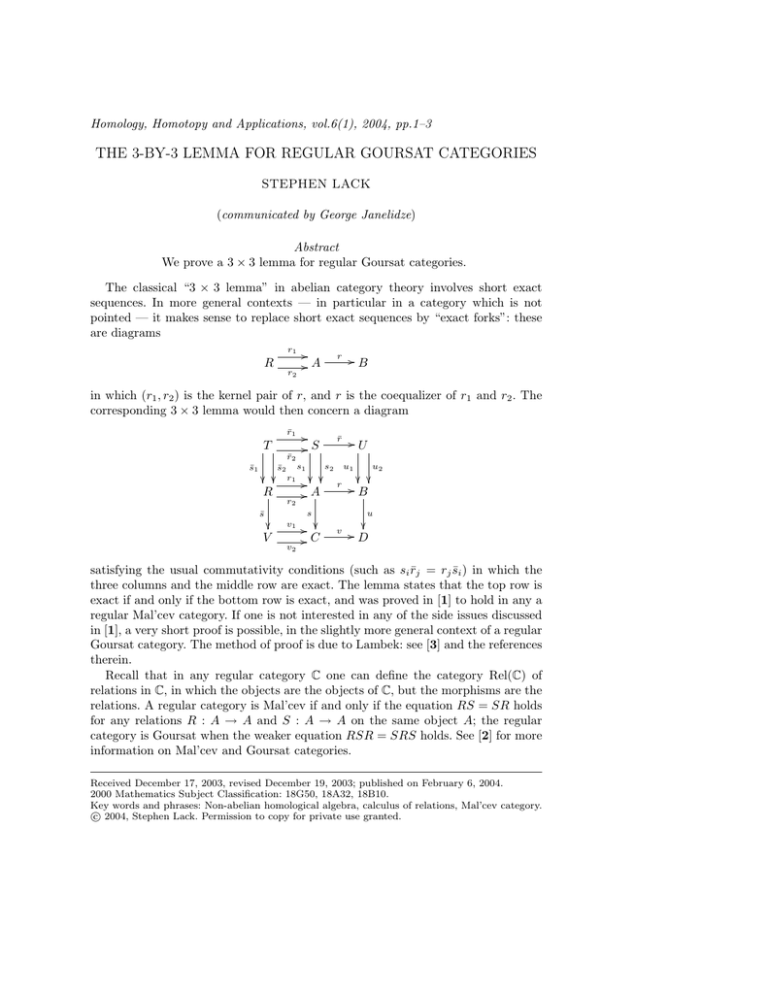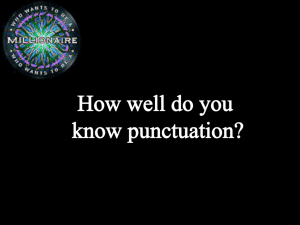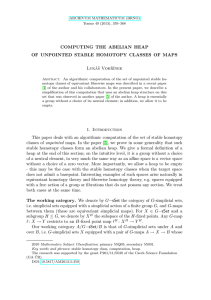THE 3-BY-3 LEMMA FOR REGULAR GOURSAT CATEGORIES
advertisement

Homology, Homotopy and Applications, vol.6(1), 2004, pp.1–3 THE 3-BY-3 LEMMA FOR REGULAR GOURSAT CATEGORIES STEPHEN LACK (communicated by George Janelidze) Abstract We prove a 3 × 3 lemma for regular Goursat categories. The classical “3 × 3 lemma” in abelian category theory involves short exact sequences. In more general contexts — in particular in a category which is not pointed — it makes sense to replace short exact sequences by “exact forks”: these are diagrams r1 R / /A r2 r /B in which (r1 , r2 ) is the kernel pair of r, and r is the coequalizer of r1 and r2 . The corresponding 3 × 3 lemma would then concern a diagram r̄1 T s̄1 ² ² R r̄2 s1 s̄2 r1 r2 r̄ s2 /² ² /A v1 v2 / ² /C /U u1 u2 r ² ² /B v ² /D s s̄ ² V / /S u satisfying the usual commutativity conditions (such as si r̄j = rj s̄i ) in which the three columns and the middle row are exact. The lemma states that the top row is exact if and only if the bottom row is exact, and was proved in [1] to hold in any a regular Mal’cev category. If one is not interested in any of the side issues discussed in [1], a very short proof is possible, in the slightly more general context of a regular Goursat category. The method of proof is due to Lambek: see [3] and the references therein. Recall that in any regular category C one can define the category Rel(C) of relations in C, in which the objects are the objects of C, but the morphisms are the relations. A regular category is Mal’cev if and only if the equation RS = SR holds for any relations R : A → A and S : A → A on the same object A; the regular category is Goursat when the weaker equation RSR = SRS holds. See [2] for more information on Mal’cev and Goursat categories. Received December 17, 2003, revised December 19, 2003; published on February 6, 2004. 2000 Mathematics Subject Classification: 18G50, 18A32, 18B10. Key words and phrases: Non-abelian homological algebra, calculus of relations, Mal’cev category. c 2004, Stephen Lack. Permission to copy for private use granted. ° Homology, Homotopy and Applications, vol. 6(1), 2004 2 Proof of the lemma Under no assumptions on the category at all, a straightforward diagram chase gives: (a) if r̄ is epi then v is the coequalizer of v1 and v2 , and (b) if the pair (v1 , v2 ) is jointly monic then (r̄1 , r̄2 ) is the kernel pair of r̄. In particular, the fact that the bottom row is a coequalizer if the top one is so is very well known. It remains to show: (c) if the bottom row is exact then r̄ is regular epi, and (d) if the top row is exact then (v1 , v2 ) is the kernel pair of v. Suppose that the category C is regular Goursat, and work now in Rel(C). Identify an arrow f : A → B in C with the corresponding relation from A to B, and write f ∗ for its opposite. Recall that f is regular epi if and only if f f ∗ = 1, and that a jointly monic pair f1 , f2 : R → A is the kernel pair of f if and only if f ∗ f = f2 f1∗ . Observe also that, by the definition of composition of relations, if in r1 R r2 / /A g ² S f s1 s2 / ² /B R and S are relations, then g is regular epi if and only if s2 s∗1 = f r2 r1∗ f ∗ . If (r1 , r2 ) and (s1 , s2 ) are kernel pairs, with coequalizers r and s, this is in turn equivalent to s∗ s = f r∗ rf ∗ . Then to prove (c) we have: u∗ u = rr∗ u∗ urr∗ = rs∗ v ∗ vsr∗ = rs∗ sr∗ rs∗ sr∗ = rr∗ rs∗ sr∗ rr∗ = rs∗ sr∗ (ur = vs) (v ∗ v = sr∗ rs∗ since s̄ is regular epi) (Goursat) and so r̄ is indeed regular epi. To prove (d): v ∗ v = ss∗ v ∗ vss∗ = sr∗ u∗ urs∗ = sr∗ rs∗ sr∗ rs∗ (ur = vs) (u∗ u = rs∗ sr∗ since r̄ is regular epi) = ss∗ sr∗ rs∗ ss∗ (Goursat) = sr∗ rs∗ = sr2 r1∗ s∗ = v2 s̄s̄∗ v1∗ (sri = vi s̄) = v2 v1∗ Homology, Homotopy and Applications, vol. 6(1), 2004 3 and so the kernel pair (v10 , v20 ) will satisfy vi0 e = vi for some regular epimorphism e; we must prove that e is invertible. In the 3-by-3 diagram now replace (v1 , v2 ) by (v10 , v20 ), and replace s by es. Then the three rows, the central column and the right column are all exact, so by (a) and (c) the left column is exact. Thus s and es are both coequalizers of s1 and s2 , so e is invertible, and the proof is complete. References [1] D. Bourn, The denormalized 3 × 3 lemma, J. Pure Appl. Alg. 177:113–129, 2003. [2] A. Carboni, G.M. Kelly, and M.C. Pedicchio, Some remarks on Maltsev and Goursat categories, Appl. Cat. Struct. 1:385–421, 1993. [3] A. Carboni, J. Lambek, and M.C. Pedicchio, Diagram chasing in Mal’cev categories, J. Pure Appl. Alg. 69:271–284, 1991. This article may be accessed via WWW at http://www.rmi.acnet.ge/hha/ or by anonymous ftp at ftp://ftp.rmi.acnet.ge/pub/hha/volumes/2004/n1a1/v6n1a1.(dvi,ps,pdf) Stephen Lack s.lack@uws.edu.au School of Quantitative Methods and Mathematical Sciences University of Western Sydney Locked Bag 1797 Penrith South DC NSW 1797 Australia







